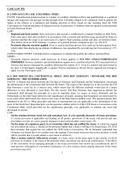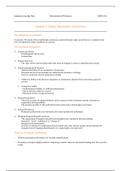Introduction
Why gender (diversity) in organizations?
Men and women are not treated equally mostly men at higher places
- Expect same experiences, but don’t know what is behind the different doors
Try to understand why this is the case what is happening? What are the underlying
processes and practices?
Have a critical perspective
Main concepts
1. Sex
Biological sex that we have, that we get assigned by our biological features
Dichotomy either this or that (men and women)
2. Gender
Social construction of what we think is masculine/feminine
Can change throughout the years/contexts
3. Gender in organizations
Certain stereotypes/roles that are connected to men/women
Use gender as an instrument of analysis look at the organization with gender lens,
and through that try to understand how organizations function
‘We do gender’ constructed and maintained in organizations
Central debates
1. Public – private men go out in the public and women stay at home
2. Difference – equality
Difference: men and women are different and should value their differences
Equality: men and women are equal and should be treated the same
3. Pluriformity and diversity – oneness and variety
Pluriformity: different versions of people
Oneness: different versions but no one is better than the other
Concepts and debates
Teaching case 1
Is a research on ethnic diversity and career sin professional service firm in the Netherlands
current representation of minority ethnics
These firms have a strict up-or-out system career decisions based on evaluation systems
Six variables
- Measurements of objective career success
1. Development of salary
2. Opportunity to advance in career
3. Time spent at functional level 5 (second highest)
- Comparison of evaluations of dominant ethnic men and women
4. Year-end review
5. Performance evaluation by professional development manager
6. Performance evaluation of the competence ‘(inter)personal communication’ by
professional development manager
dominant ethnics scored better
Demonstrates the challenge of the number-game
1
,Gatrell & Swan | Gender and diversity in management: a concise introduction
Chapter 1 – What do we mean by gender and diversity n management
Minoritized groups continue to face oppression and unequal treatment at work through
inequality regimes
Gender is a social construction activity produced in and through the workplace
Three main levels
- Individual individualized processes or practices (how the person experiences and
performs gender)
- Interactional social interaction (react and interact with each other)
- Institutional social practices, structures, processes, cultures of organizations and
institutions (how organizations lead to and maintain certain ideas)
Different views lead to an ongoing debate about whether a theoretical and a practical focus
should be on gender in management, rather than on women in management
Intersectionality social categories of race, gender, sexuality, disability, age and class are
understood as interrelating and mutually constituting
Chapter 2 – Introducing gender in management
There can be an assumption that women’s rights have been achieved and inequality
vanquished but below the surface it doesn’t seem so equal
- Gender pay gap, representation of women in leadership positions, career opportunities
for women, women in family owned business face glass ceiling
For black and minority ethnic women, the situation is even worse concrete wall
Can examine the history
- Women have been associated with homemaking and men with employment still
hold these assumptions
- Women are socialized in different ways from men when they are growing up image
of ideal womanhood
- In historical and legislative practice, it can be seen that women were rarely associated
with management unless this related to management within the domestic setting
Movements
1. Liberal feminism
Started in 1960s and 1970s
Important aspect was the idea of expanding the concept of work and workplace
wages for housework
Asserts that women’s equality with men should be achieved through incremental
changes in the education and legal system
Does not challenge the binary categories of men and women
Critized because it failed to distinguish between different groups of women
Most attractive to policy makers and governing bodies
2. Feminist Marxism and capital relations
It is based on the view that capitalism as an economic system is reliant on particular
ways of organizing work relations or so-called relations of production
Main focus on the exploitation of the working class by the middle class
Critique by feminists for having a lack of attention to gender they argue that
relations of reproduction, that is the domestic work that women undertake, are
essential for continuing the relations of production – in the workplace
3. Patriarchy and women’s oppression
Patriarchy is understood as a system of social structures and practices which are used
by men to dominate and oppress women
2
, Women become used to being patronized and excluded from social opportunities from
childhood
4. Radical feminism
Believe that it is gender relations rather than class relations that generate fundamental
inequalities in the social world
Women are understood as having different experiences, interests and ways of being
from men celebrate the concepts of womanhood and sisterhood
Chapter 1 | Theorizing gender and organization
Two main approaches
1. Gender in organizations
Gender = sex = women (and men)
Question: Why don’t women achieve
Role theory women are disadvantaged because stereotypes suggest they
don’t fit
Status processes women seen as having less status
Gender as primary cultural frame as people automatically and routinely sex-
categorize one another they implicitly draw on gender stereotypes in which
status beliefs and beliefs about traits and roles are embedded
System is assumed to be gender neutral based on cognitive processes
2. Gendering organizations
Gender as a social process doing of gender
Question of inequality turned around towards understanding its production and
reproduction in situated circumstances where gender is done as power relations
Point is that not women are different, but that gender difference is the basis for the
unequal distribution of power and resources
Embodiment, sexuality, masculinity, hierarchy and gender order
Most potential for gendering organizations
Globalization and a transnational work system are changing the contours of inequality and
imply a need for different approaches to analysis
Towards intersectional and transnational feminist analysis
- Transnational feminist analyses decenter privileged subjects in organizations and
focus instead on relations among the multitude of subjects and processes which labor
in the global economy in specific times and spaces
- Intersectionality refers to how social and cultural categorizations interact on multiple
and often simultaneous levels, contributing to systemic social inequality
Central concept: power
Power
- Suppression and patriarchy women are oppressed
- Inequality between women and men in terms of power, access to aims, sources of
information, positions women may also have power (scale)
- Structure and agency how the social context and the individual interact (every
individual has power within this system we created together)
Labor market, organization and the individual
Chapter 2 | Disturbing thoughts and gender practices
Discursive review of feminist organizational analysis
- Take a discursive lens to avoid the problem of trying to represent a series of events as
a linear and/or progressive history
3












